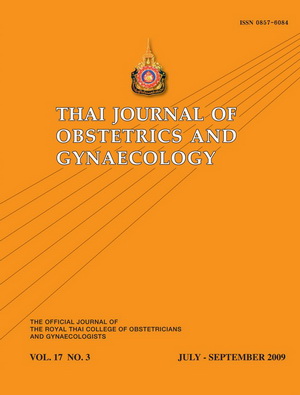Umbilical Cord Prolapse and Perinatal Outcomes
Main Article Content
Abstract
Objective:
To study the prevalence and perinatal outcomes of pregnancy with umbilical cord
prolapse.
Study design:
Retrospective descriptive study
Subjects:
The equal or more than 24 weeks gestational age pregnant women with umbilical cord
prolapse who delivered at Ramathibodi Hospital from 1 January 1998 to 31 December 2007.
Materials and methods:
Maternal and fetal data from medical records of umbilical cord prolapse
cases were reviewed for parity, age, gestational age, fetal presentation, status of membranes,
interval from diagnosis to delivery, modes of delivery, fetal weight and Apgar scores, then the
data were analyzed.
Main outcomes:
Prevalence of umbilical cord prolapse, severe birth asphyxia (Apgar scores at 1
minute ≤ 3) and perinatal mortality.
Results:
There were 42 cases of umbilical cord prolapse from 25,707 deliveries (prevalence
0.16%). Nine fetuses (21.4%) were severe birth asphyxia and six fetuses (14.2%) die. The
perinatal mortality was 0.2 per 1,000 live births. The mean interval from diagnosis to delivery
was 25.1ฑ8.5 minutes.
Conclusion:
The prevalence of umbilical cord prolapse was 0.16%, the perinatal outcomes
demonstrated by the severe birth asphyxia was 21.4% and the perinatal mortality was 0.2 per
1,000 live births.

